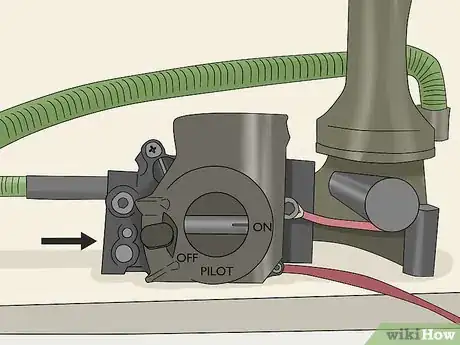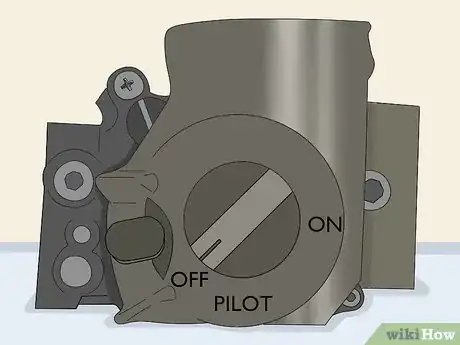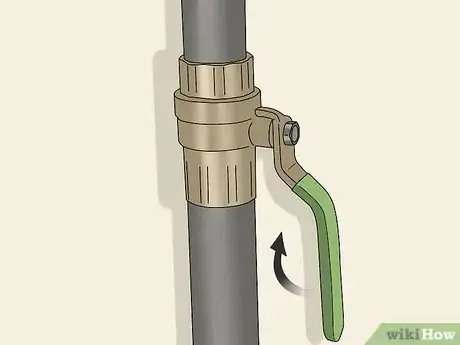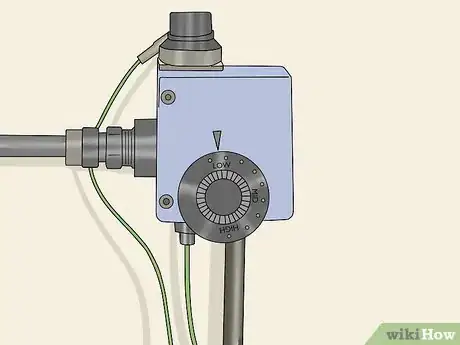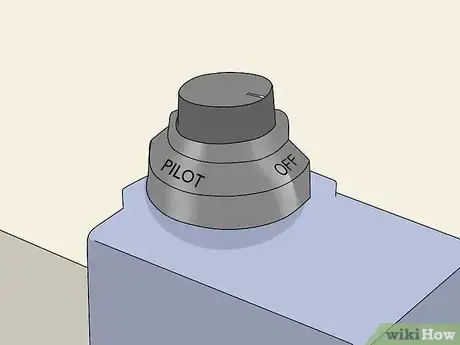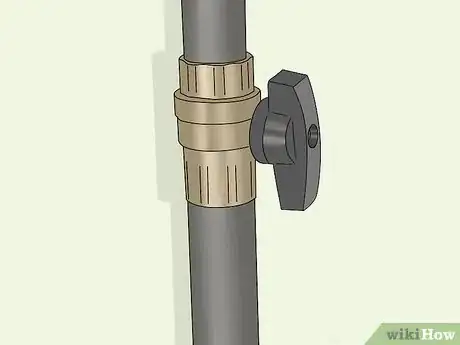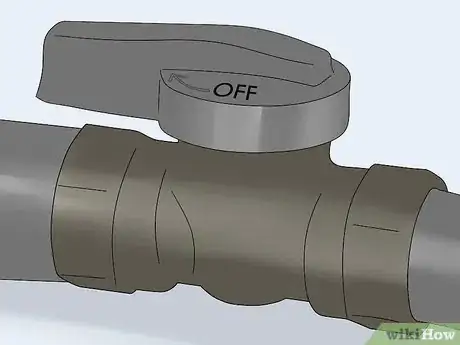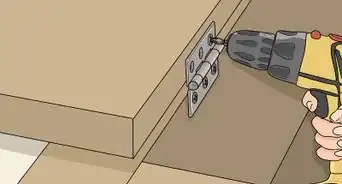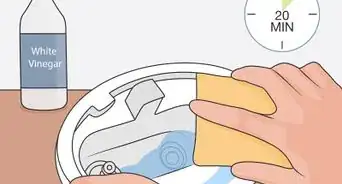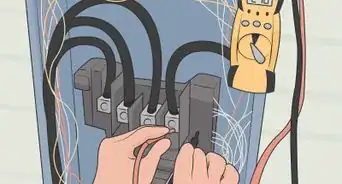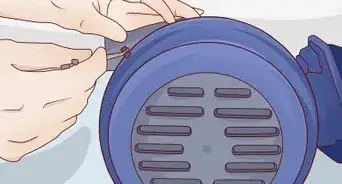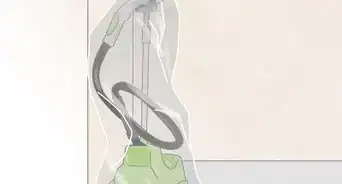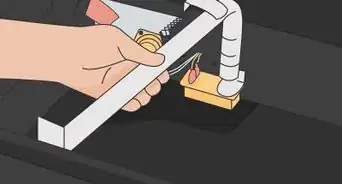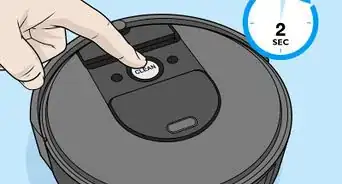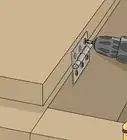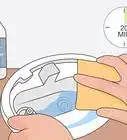This article was co-authored by wikiHow staff writer, Hunter Rising. Hunter Rising is a wikiHow Staff Writer based in Los Angeles. He has more than three years of experience writing for and working with wikiHow. Hunter holds a BFA in Entertainment Design from the University of Wisconsin - Stout and a Minor in English Writing.
There are 9 references cited in this article, which can be found at the bottom of the page.
This article has been viewed 32,325 times.
Learn more...
Gas appliances have pilot lights that stay lit at all times to burn off excess natural gas coming through the system. If you need to perform maintenance, turning off the pilot light is as simple as turning off the gas supply to the appliance. While each type of appliance has a few additional steps you need to complete, they all require you shutting off the gas. Once you’re finished with your repairs or you want to use the machine again, just ignite the pilot light!
Steps
Extinguishing a Gas Furnace Pilot Light
-
1Turn your thermostat off or as low as possible. If your thermostat controller has an “Off” switch, then turn it off completely so the furnace isn’t running anymore. If you aren’t able to turn the thermostat off entirely, set it to the lowest temperature possible. That way, the furnace won’t kick in while you’re trying to turn off the pilot light.[1]
- The thermostat is usually located on a wall in one of the main rooms of your home, or it may be near the furnace.
-
2Locate the dial or valve behind an access panel or on the gas intake pipe. Inspect your furnace and search for a small black or green dial that’s labeled “On,” “Off,” and “Pilot.” If you can’t find the dial on the outside, then check for one behind an access panel near the bottom of your furnace. If you still aren’t able to find a dial, then you may need to turn the gas off at the intake pipe. Look for a straight or round lever on the gas line leading to the furnace.[2]
- If you still aren’t able to find the valve or dial that controls your furnace, check the furnace’s user manual to see if you can locate it. If you don’t have a manual, then you may need to call in a repairperson.
- It’s possible that your furnace has both types of shut-off valves. Always try to turn the furnace off first before switching the gas line off.
Advertisement -
3Switch the dial to the “Off” position if your furnace has one. Once you find the dial, press down on it so you’re able to rotate it. Turn the dial so the arrow or mark on top points to the “Off” position. Once the dial is turned off, the gas supply will shut off for your furnace and cause the pilot light to turn off.[3]
- Turning off the pilot light on your furnace during the summer months may be able to save you up to $50-60 USD in gas each year.
- If the dial doesn’t turn easily, don’t try to force it off since you may have a faulty component. If you feel like you need to force the dial to the “Off” position, call a professional to inspect or replace it.
-
4Rotate the gas valve on the intake pipe to turn it off. If you have a straight lever controlling the gas intake, turn the lever so it points away from the pipe. If there’s a round knob instead of a lever, rotate it clockwise as far as you’re able to turn off the gas supply. Your furnace pilot light may take a few seconds to go out, but it will turn off once it burns through the gas.[4]
- Put a piece of tape on the lever or knob so no one accidentally turns it back on. That way, you can prevent accidental gas leaks.
Tip: The pilot light may stay on for a few seconds after you turn off the furnace since there is still natural gas in the intake pipe.
Turning off a Water Heater’s Pilot Light
-
1Set the water heater to the lowest temperature possible. Locate the dial on the side of your water heater near the power witches and intake ports. Spin the dial clockwise to reduce the temperature of the heater as low as possible. This will make the flames the smallest and reduce the amount of gas coming into it.[5]
- The dial may not be labeled with specific temperatures. If not, turn the dial clockwise as far as you can or until it says “Pilot Lighting.”
-
2Switch the button on the water heater to the “Off” position. Locate the button that’s labeled “On,” “Off,” and “Pilot” above the temperature dial. Press down on the button so you’re able to rotate it, and turn it until the arrow points to the “Off” position. The switch will turn off the gas supply and extinguish the pilot light inside your water heater.[6]
- You won’t be able to use hot water while the water heater is turned off.
-
3Remove the access panel on your water heater to check if the light is out. Look for the access panel on the bottom of your water heater, and remove it. Behind the access panel, you’ll either find an opening or a viewing window so you can look inside your water heater. If there isn’t a flame inside the water heater, then switching it off worked. If you still see a flame, then you may have a faulty part that doesn’t work.[7]
- You may need a screwdriver to remove the access panel from your water heater, but it depends on the model.
-
4Turn the gas intake valve perpendicular to the pipe if the pilot light is still on. The gas intake pipe leads directly into the bottom of the water heater. Follow the pipe back up until you find an intake valve, which will have a straight lever that’s parallel with the pipe. Rotate the lever until it’s perpendicular with the pipe to shut off the gas supply to the heater.[8]
- If you hear a hissing sound or smell natural gas while you’re working, then you may have a gas leak. Get out of the area with the leak and contact your gas company to let them know about your problem.
- Don’t try to force the gas valve open if it doesn’t rotate easily. Call a professional to look at the valve for you since it may be faulty.
Tip: If your intake valve has a circular knob, rotate it clockwise until you can’t turn it anymore to shut the gas off.
Putting out an Oven’s Pilot Light
-
1Slide your oven away from the wall to access the gas line. Lift the front of your oven, and slide fabric or cloth underneath the feet to prevent scratching your floor. Carefully hold onto your oven and pull it straight out from the wall until you can see the gas valve behind it. Be careful not to pull the oven out too far, or else you could break the hose connecting the gas to your oven.[9]
Tip: The gas valve may also be at the back of a cabinet right next to your oven. Check your cabinets to see if there are any valves there before you move your oven.
-
2Switch the oven’s gas valve to the “Off” position. The gas valve will either have a straight lever or a round knob controlling the intake. If there is a straight lever, turn it until it’s perpendicular with the pipe to close the valve. If there is a round knob instead, then rotate it clockwise as far as it will go. The pilot light may take a few seconds to extinguish as it burns through any residual gas.[10]
- You won’t be able to use your oven while the gas is disconnected.
- If you smell a strong natural gas odor or hear a hissing noise, open nearby windows before leaving the area. Contact your gas company or emergency services to let them know of a leak.
- Don’t force the valve closed if it doesn’t move easily. Contact a repair person to inspect or replace the valve for you.
-
3Check inside your oven to make sure the pilot light went out. The pilot light is usually located in one of the bottom corners inside your oven. Open the oven door and look for a “Pilot Light” label printed somewhere inside. Check that the pilot light is completely extinguished and there is no smell of natural gas. If you can’t see a light, then you can continue with repairs or anything you need to complete.[11]
- If you can see a pilot light still lit, then there is something wrong with the intake valve connecting to it.
Warnings
- If your home smells like natural gas, don’t use any electronics or open flames and leave the area immediately. Once you’re out of the building, call emergency services to let them know about a potential gas leak.⧼thumbs_response⧽
- Avoid trying to extinguish the pilot light without turning off the gas since you could allow natural gas to leak into your home.⧼thumbs_response⧽
- Don’t try to start a pilot light if it smells like natural gas since it could combust.⧼thumbs_response⧽
References
- ↑ http://www.iwilltry.org/b/projects/turn-off-the-pilot-flame-of-your-gas-furnace/
- ↑ https://youtu.be/GX-QWkihYXg?t=3
- ↑ https://youtu.be/GX-QWkihYXg?t=30
- ↑ http://www.iwilltry.org/b/projects/turn-off-the-pilot-flame-of-your-gas-furnace/
- ↑ https://youtu.be/8GWOoYwwgcU?t=52
- ↑ https://www.homestructions.com/general/turn-off-water-heater/
- ↑ https://youtu.be/8GWOoYwwgcU?t=68
- ↑ https://www.homestructions.com/general/turn-off-water-heater/
- ↑ https://youtu.be/pSiFHQpoENg?t=8

